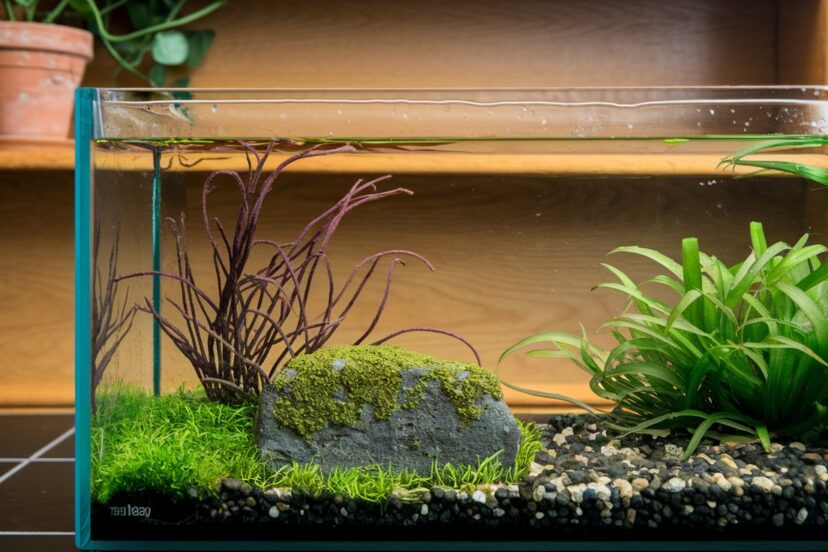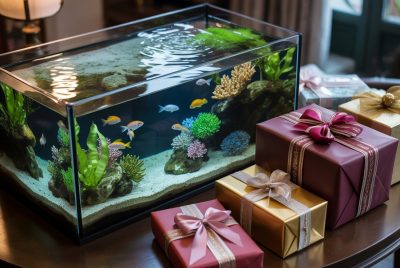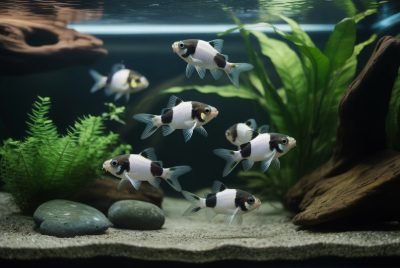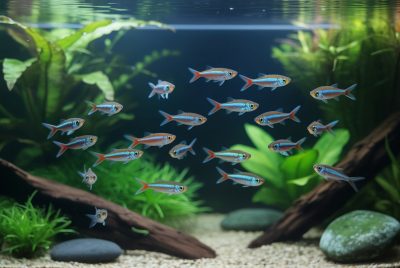The Nitrogen Cycle in Aquascaping
*We may earn a commission for purchases made using our links. Please see our disclosure to learn more.
Beneath the tranquil surface of every thriving aquascape lies an invisible yet powerful force: the nitrogen cycle. This microscopic ecosystem is the lifeblood of aquatic environments, transforming potentially deadly waste compounds into manageable nutrients through a remarkable bacterial dance. For both novice and experienced aquascapers, mastering this biological process often marks the difference between a flourishing underwater landscape and a troubled tank plagued by algae, cloudiness, and fish mortality.
Key Takeaways
- The nitrogen cycle is essential: It converts toxic ammonia from waste into less harmful nitrates through beneficial bacteria.
- Cycling takes time: Establishing a complete nitrogen cycle typically requires 4-6 weeks of patience.
- Testing is crucial: Regular water testing helps monitor ammonia, nitrite, and nitrate levels throughout the cycling process.
- Plants play a dual role: Aquatic plants both contribute to and benefit from different stages of the nitrogen cycle.
- Balance is the goal: A mature, balanced nitrogen cycle creates stability that supports both flora and fauna in your aquascape.
“The nitrogen cycle isn’t just biological filtration—it’s the ecological foundation that makes the underwater world possible. Understanding this cycle is perhaps the single most important factor in successful aquarium keeping.”
— Takashi Amano, Nature Aquarium World (1994)
Understanding the Basics of the Nitrogen Cycle
At its core, the nitrogen cycle in an aquarium represents nature’s waste management system. This biological process involves the transformation of nitrogenous compounds through several stages, facilitated by different bacterial colonies. To fully appreciate how this affects your aquascape, we need to examine each phase of this cycle.
The Four Phases of the Nitrogen Cycle
1. Ammonia Production
The cycle begins with ammonia (NH₃), which enters the aquarium system from several sources:
- Fish excrete ammonia directly through their gills and as waste
- Uneaten fish food decomposes, releasing ammonia
- Plant material breaks down when leaves or stems die
- Organic debris accumulates in substrate and filter media
Ammonia is highly toxic to fish and invertebrates, even at low concentrations. In an uncycled tank, ammonia levels can rapidly reach lethal levels within days. This explains why adding fish to a newly established aquarium often results in what hobbyists call “new tank syndrome”—essentially, ammonia poisoning.
The toxicity of ammonia varies with pH and temperature. In higher pH environments (above 7.0), ammonia exists predominantly in its un-ionized form (NH₃), which is considerably more toxic than the ionized form (NH₄⁺) that predominates in acidic conditions. This relationship becomes particularly important in planted aquascapes, which may experience pH fluctuations throughout the day due to photosynthesis.
2. Nitrite Formation
As the aquarium matures, beneficial bacteria from the genus Nitrosomonas colonize surfaces in the tank, particularly the filter media, substrate, and decorative elements. These aerobic bacteria oxidize ammonia into nitrite (NO₂⁻) through the following biochemical process:
NH₃ + O₂ → NO₂⁻ + 3H⁺ + 2e⁻
While this transformation represents progress in the cycling process, nitrite remains highly toxic to aquatic life, sometimes even more so than ammonia. During this phase, fish still face considerable stress and potential health risks.
Nitrite toxicity manifests through interference with oxygen transport in fish blood, causing a condition known as “brown blood disease” or methemoglobinemia. Fish suffering from nitrite poisoning may exhibit rapid gill movement, gasping at the surface, lethargy, and discoloration. Interestingly, the addition of small amounts of salt (sodium chloride) can temporarily protect fish from nitrite toxicity by blocking nitrite uptake at the gills—a useful emergency measure in cycling mishaps.
3. Nitrate Production
The third phase involves another group of beneficial bacteria, primarily from the genus Nitrobacter, which convert the harmful nitrites into less toxic nitrates (NO₃⁻):
NO₂⁻ + H₂O → NO₃⁻ + 2H⁺ + 2e⁻
Nitrates represent the final product of bacterial nitrification in most aquariums. While significantly less toxic than both ammonia and nitrite, nitrates can still become problematic at high concentrations, potentially causing algae blooms and stressing aquatic life over time.
Most freshwater fish can tolerate nitrate levels up to 40-50 ppm without acute distress, though long-term exposure to levels above 20 ppm may cause subtle health issues and reduced spawning success. Sensitive species like discus and some shrimp varieties show stress at even lower concentrations, making nitrate management particularly important in specialized aquascapes featuring these organisms.
4. Nitrate Reduction and Removal
In natural ecosystems, the nitrogen cycle completes through denitrification—where anaerobic bacteria convert nitrates back to atmospheric nitrogen. In home aquascapes, this process occurs minimally in oxygen-poor areas like deep substrate layers. More commonly, aquascapers manage nitrate levels through:
- Water changes to dilute accumulated nitrates
- Heavy planting with fast-growing species that consume nitrates
- Special filtration media designed to remove nitrates
- Dedicated denitrifying filters that create anaerobic zones for complete denitrification
The degree to which denitrification occurs naturally in aquascapes depends largely on substrate depth and composition. Traditional aquascaping substrates like ADA Aquasoil or deep sand beds (over 3 inches/7.5 cm) can develop anaerobic zones where denitrifying bacteria thrive. These bacteria use nitrate as an electron acceptor in the absence of oxygen, converting it to nitrogen gas which then escapes through the water column. This process can be encouraged through strategic substrate layering and minimal disturbance of established substrate beds.
Cycling Your Aquascape
Methods for Establishing the Nitrogen Cycle
Fishless Cycling
The most ethical and effective approach to establishing the nitrogen cycle is fishless cycling. This method involves:
- Setting up the aquarium with substrate, hardscape elements, and filtration systems
- Adding an ammonia source, either through pure ammonia (dosing to 2-4 ppm) or decomposing organic matter like fish food
- Testing regularly to monitor ammonia, nitrite, and nitrate levels
- Allowing bacterial colonization to occur naturally over 4-6 weeks
- Confirming cycle completion when added ammonia converts completely to nitrate within 24 hours
Fishless cycling allows beneficial bacterial colonies to establish without endangering aquatic life. The process can be accelerated by maintaining warm water temperatures (75-82°F/24-28°C), ensuring good oxygenation, and introducing bacterial cultures from established aquariums.
The mechanics of fishless cycling require patience and precision. When using pure ammonium chloride (often sold as “fishless cycling ammonia”), dosing should aim for 2-4 ppm initially, with subsequent doses added whenever ammonia readings drop below 1 ppm. This maintains constant pressure for bacterial growth without reaching toxic concentrations that might inhibit bacterial development. Regular testing is essential—ideally using liquid test kits rather than strips for greater accuracy during this critical phase.
Silent Cycling with Plants
Heavily planted aquascapes offer an alternative approach known as “silent cycling” or the “Walstad method.” Plants absorb ammonia directly, reducing toxicity while bacteria colonies develop gradually. This approach requires:
- Dense planting from the start (covering at least 70% of the substrate)
- Focus on fast-growing species like stem plants
- Limited initial livestock with gradual increases
- Low initial lighting to prevent algae outbreaks before plants establish
This method leverages the plant-bacteria partnership to create a more natural, gradual cycling process.
Silent cycling represents a more holistic ecosystem approach that attempts to replicate natural water bodies where plants, bacteria, and animals establish a balance without human intervention. The success of this method depends heavily on plant selection and density. Ideal species include fast-growing stem plants like Limnophila sessiliflora, Hygrophila polysperma, Rotala rotundifolia, and floating plants like Pistia stratiotes or Salvinia natans which have direct access to atmospheric CO₂ and can grow explosively, consuming significant amounts of nitrogen compounds.
The Role of Plants in the Nitrogen Cycle
Plants interact with the nitrogen cycle in complex ways that both support and complicate aquascape management:
Nitrogen Consumption
Aquatic plants preferentially absorb ammonia as their nitrogen source, followed by nitrates when ammonia is unavailable. This consumption directly competes with nitrifying bacteria but benefits water quality by reducing toxicity. Fast-growing stem plants like Rotala, Ludwigia, and Hygrophila species serve as particularly effective “nutrient sponges.”
The evolutionary preference for ammonia uptake makes botanical sense—plants save energy by absorbing ammonia directly rather than reducing nitrate back to ammonia internally before assimilation into amino acids. This preference creates an interesting dynamic in heavily planted tanks where bacterial colonies may develop more slowly due to competition for ammonia. However, plants also provide extensive surface area for bacterial colonization, potentially increasing overall biofiltration capacity once established.
Oxygen Production
During photosynthesis, plants release oxygen that supports aerobic nitrifying bacteria. This oxygen production is highest during peak lighting periods, creating a daily rhythm in bacterial activity.
The diurnal oxygen cycle in planted tanks significantly impacts bacterial performance. During daylight hours when photosynthesis is active, dissolved oxygen levels may reach supersaturation (above 100%), creating ideal conditions for nitrifying bacteria. At night, plants become oxygen consumers through respiration, potentially reducing dissolved oxygen. In densely planted tanks with limited surface agitation, this nighttime oxygen drop can temporarily reduce nitrification efficiency, especially in high-tech setups with CO₂ injection and high plant mass.
Microenvironments
Plant roots release oxygen into the substrate, creating microenvironments where both nitrification and limited denitrification can occur simultaneously. These root zones become hotspots of bacterial activity.
The rhizosphere—the area immediately surrounding plant roots—hosts a microbial community distinct from the general substrate. Root exudates provide carbon sources for heterotrophic bacteria, while oxygen release supports nitrification. In established aquascapes, these root systems create an intricate underground network that significantly enhances biological filtration capacity beyond what mechanical filters alone could achieve.
Organic Matter Contribution
As plants shed leaves or undergo trimming, they contribute organic matter that decomposes and releases ammonia, becoming part of the nitrogen input stream that bacteria process.
Regular maintenance becomes crucial in heavily planted systems to prevent excessive organic accumulation. Trimmings should be promptly removed, and deteriorating leaves pinched off before they can fully decompose. Some aquascapers employ cleanup crews of detritivores like shrimp, snails, and certain catfish species to manage this organic matter, creating additional trophic levels within the nitrogen cycle ecosystem.
Monitoring and Maintaining the Nitrogen Cycle
Essential Testing Parameters
Successful aquascaping requires regular monitoring of key water parameters:
- Ammonia (NH₃/NH₄⁺): Should read 0 ppm in an established tank
- Nitrite (NO₂⁻): Should also read 0 ppm in a mature system
- Nitrate (NO₃⁻): Ideally kept below 20 ppm for planted tanks, though some plant species thrive with slightly higher levels
- pH: Influences the toxicity of ammonia and affects bacterial activity
- Temperature: Affects bacterial metabolism and cycling speed
Testing frequency should be higher during initial cycling (every 2-3 days) and can decrease to weekly or bi-weekly once the system stabilizes.
The relationship between these parameters creates a complex interplay that experienced aquascapers learn to interpret. For instance, a sudden drop in nitrate levels without water changes might indicate either increased plant uptake (positive) or a cycle crash affecting the nitrite-to-nitrate conversion bacteria (concerning). Similarly, a tank that never shows nitrate accumulation despite stable ammonia and nitrite readings at zero might be experiencing efficient denitrification or extraordinary plant consumption—both desirable outcomes requiring different management approaches.
Common Cycling Problems and Solutions
Stalled Cycles
Occasionally, the nitrogen cycle appears to stall, with ammonia decreasing but nitrites failing to appear, or nitrites persisting without conversion to nitrates. Common causes include:
- pH instability: Nitrifying bacteria prefer stable pH between 7.0-8.0
- Insufficient oxygen: Ensure proper surface agitation without disrupting your aquascape design
- Chemical inhibitors: Medications, chlorine/chloramine, or heavy metals can suppress bacterial growth
- Lack of surface area: Add biomedia to increase colonization space for bacteria
The solution typically involves addressing these limitations while maintaining patience—bacterial colonies sometimes require additional time to establish properly.
Many commercial aquasoils, particularly those designed for aquascaping, can release ammonia during the initial weeks of setup. This “substrate leaching” provides a natural ammonia source that can jump-start cycling but may also prolong the process as the substrate continues releasing ammonia. Understanding this characteristic helps explain seemingly prolonged cycling phases in new aquascapes and suggests that additional ammonia dosing may be unnecessary when using these specialized substrates.
Cycle Crashes
Even established aquascapes can experience cycle “crashes” where beneficial bacterial colonies suddenly decline, causing ammonia and nitrite spikes. Potential triggers include:
- Filter cleaning with tap water containing chlorine
- Medication treatments targeting bacterial infections
- Extended power outages reducing oxygen availability
- Sudden temperature fluctuations stressing bacterial colonies
- Overstocking or overfeeding beyond the system’s processing capacity
Recovery requires reducing feeding, performing water changes to dilute toxins, introducing bacterial supplements, and addressing the root cause of the crash.
The resilience of an established nitrogen cycle depends largely on system maturity and bacterial diversity. Tanks that have been running for years often develop redundant bacterial populations across various surfaces beyond just the filter media. This redundancy provides insurance against partial system disruptions. For this reason, experienced aquascapers often recommend against replacing all filter media simultaneously or performing massive (>70%) water changes that could disrupt the carefully balanced microbial ecosystem.
Advanced Nitrogen Cycle Concepts for Aquascapers
Bacterial Diversity and Modern Understanding
Contemporary research has expanded our understanding of aquarium nitrification beyond the simplified Nitrosomonas and Nitrobacter model. Modern scientific analysis reveals:
- Nitrospira bacteria capable of complete ammonia-to-nitrate conversion in one step (comammox)
- Diverse ammonia-oxidizing archaea that may dominate in certain aquarium conditions
- Multiple genera of nitrite-oxidizing bacteria beyond just Nitrobacter
- Heterotrophic bacteria that process organic carbon while also assimilating nitrogen
This diversity explains why bacterial supplements vary in effectiveness and why some tanks develop robust cycles more quickly than others despite similar conditions. Understanding this complexity encourages aquascapers to focus on creating conditions favorable for diverse microbial communities rather than fixating on specific bacterial genera.
Balancing the Nitrogen Cycle in Different Aquascaping Styles
Different aquascaping approaches require tailored nitrogen cycle management:
Nature Aquariums (Amano Style)
These plant-dominated systems typically feature:
- High plant mass requiring substantial nitrogen inputs
- Lean water column dosing with substrate-focused nutrition
- Regular trimming generating organic matter
- Periodic substrate refreshing that can disrupt bacterial colonies
The nitrogen cycle management focuses on encouraging robust plant growth while preventing ammonia spikes during maintenance. Complete filter cleaning is avoided, and substrate work is performed gradually rather than disrupting the entire tank bottom simultaneously.
Dutch Aquascapes
Characterized by:
- Extremely high plant density with multiple fast-growing species
- Intensive fertilization regimens including nitrogen supplementation
- Frequent trimming and replanting
- Minimal hardscape surface area for bacterial colonization
These systems rely heavily on plant uptake for nitrogen processing, with bacterial filtration playing a supporting role. The challenge becomes maintaining sufficient nitrogen for plant growth while preventing buildup to levels that might trigger algae.
Biotope Aquascapes
These habitat-replicating systems often feature:
- Specific water chemistry requirements that may impact bacterial activity
- Lower plant mass in some geographic representations
- Natural materials that release tannins and other compounds
- Species that may have highly specialized nitrogen tolerance ranges
The nitrogen cycle management must balance authenticity with biological function, sometimes requiring compromise between perfect biological filtration and biotope accuracy.
Conclusion
The nitrogen cycle represents the biochemical foundation upon which successful aquascapes are built. By understanding its mechanisms, monitoring key parameters, and creating conditions that support both bacterial and plant contributions to nitrogen processing, aquascapers can establish robust biological filtration systems that maintain water quality while supporting aquatic life.
Remember that patience remains the most important virtue during the cycling process—rushing this fundamental stage invariably leads to problems that can undermine even the most beautiful aquascape design. The invisible microbiome developing in your filter media, substrate, and plant surfaces deserves as much attention as the visible elements of your underwater landscape.
With proper knowledge and management of the nitrogen cycle, aquascapers can create self-sustaining ecosystems where bacterial processes, plant growth, and animal life achieve the balance that makes truly successful aquascapes possible.
Frequently Asked Questions
1. How long does it typically take to cycle a new aquascape?
The complete nitrogen cycle typically establishes in 4-6 weeks under optimal conditions. Factors that influence timing include temperature, oxygen levels, pH stability, and the presence of starter bacteria from established tanks. Using commercial bacterial supplements may accelerate the process, but results vary widely between products. Plant-heavy setups may cycle faster due to plant uptake of ammonia, though the bacterial colonies still require time to reach peak efficiency.
2. Can I add fish before the nitrogen cycle is complete?
Adding fish before the nitrogen cycle completes is not recommended as it subjects them to toxic ammonia and nitrite, potentially causing stress, disease, or death—a practice known as “fish-in cycling.” If you must add fish early, limit numbers to absolute minimum, choose hardy species known to tolerate fluctuating water conditions, and perform frequent water changes (25-30% daily) to dilute toxins. Monitor parameters closely and use detoxifying products specifically designed to bind ammonia as temporary measures.
3. How do CO₂ injection and pH fluctuations affect the nitrogen cycle?
CO₂ injection temporarily lowers pH as carbonic acid forms, which can impact nitrifying bacteria activity and ammonia toxicity. As pH decreases, bacterial efficiency may reduce slightly, though established colonies usually adapt. More significantly, pH reduction shifts the ammonia-ammonium balance toward the less toxic ammonium form, providing a slight protective effect during cycling fluctuations. Daily pH swings in high-tech planted tanks (higher at night, lower during CO₂ injection periods) create constantly changing conditions that robust, mature bacterial colonies can handle but may stress developing colonies during initial cycling.
4. Do I need to cycle my tank again after a major rescape?
A major rescape doesn’t necessarily require complete re-cycling if you preserve filter media and some substrate containing established bacterial colonies. However, significant disruption to substrate beds, removal of large plant mass, or filter cleaning can reduce biological filtration capacity temporarily. During the week following major rescapes, reduce feeding, monitor parameters closely, and be prepared to perform water changes if ammonia or nitrite appear. Consider temporarily reducing livestock density until stability returns to provide a margin of safety.
5. How do aquasoil and specialized substrates affect the nitrogen cycle?
Aquasoil and other specialized aquascaping substrates significantly impact nitrogen cycling in several ways. Initially, many release ammonia during the first 4-8 weeks, providing both benefits (cycling fuel, plant nutrition) and challenges (delayed stability, potential toxicity). Their high cation exchange capacity buffers nitrogen compounds and can temporarily bind ammonia. Their porous structure provides extensive surface area for bacterial colonization, potentially increasing biological filtration capacity. Additionally, these substrates typically establish effective aerobic/anaerobic gradients that support both nitrification and limited denitrification simultaneously, creating more complete nitrogen processing than is possible in plain sand or gravel substrates.




